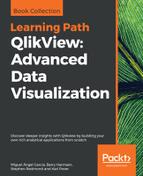Chapter 1, Performance Tuning and Scalability, is where we look at understanding how QlikView stores its data so that we can optimize that storage in our applications. We will also look at topics such as Direct Discovery and testing implementations using JMeter.
Chapter 2, QlikView Data Modeling, looks in detail at dimensional data modeling and learning about fact and dimension tables and using best practices from Ralph Kimball in QlikView. We also learn about how to handle slowly changing dimensions (SCDs), multiple fact tables, and drilling across with document chaining.
Chapter 3, Best Practices for Loading Data, is where we look at implementing ETL strategies with QVD files. We also introduce QlikView Expressor.
Chapter 4, Advanced Expressions, is where we look at areas such as the Dollar-sign Expansion, set analysis, and vertical calculations using Total and Aggr.
Chapter 5, Advanced Scripting, looks at optimizing loads, Dollar-sign Expansion in the script, and control structures. We also introduce the concept of code reuse.
Chapter 6, What's New in QlikView 12, presents a summary of the changes in the QlikView software, as well as in the Qlik ecosystem in general, that happened since the previous version of this book was published in 2012. In this chapter, we will bring you up to speed with the changes over the past few years.
Chapter 7, Styling Up, will help us learn how to style our QlikView documents. We will learn about the various document and sheet properties and will use them to manage the visual style of our document. We will also take a closer look at some of the most fundamental objects and learn how we can change their appearance.
Chapter 8, Building Dashboards, introduces us to the three basic types of QlikView users, and how we can best cater to their needs. We will learn about the various charting options that are available in QlikView, and will see how we can add interactivity to our QlikView documents. We will also be introduced to basic calculations.
Chapter 9, Advanced Data Transformation, returns to the topic of data transformation. We will learn about the most commonly used data architectures that can ease QlikView development and administration. Next, we will take a close look at aggregating and sorting data in the data model. In the fi nal part of the chapter, we will learn how to take advantage of some of QlikView's most powerful data transformation capabilities.
Chapter 10, Security, shows how to secure our QlikView documents. We will see how we can allow only authorized users to open our documents and will learn how we can limit what a user can do and see within our document.
Chapter 11, Data Visualization Strategy, begins our journey to create a data-driven organization using QlikView.
Chapter 12, Sales Perspective, explains the data model's importance to data visualization, and shows us how to create advanced analyses, such as customer stratifi cation, churn prediction, and seasonal trends.
Chapter 13, Financial Perspective, illustrates the usage of metadata to format an income statement, a balance sheet, and a cash flow statement.
Chapter 14, Marketing Perspective, walks us through various types of visualization that reveal customer profiles, potential markets, social media sentiment, and the sales pipeline.
Chapter 15, Working Capital Perspective, describes how to analyze days sales of inventory, days sales outstanding, and days payable outstanding, at both a high and a detailed level. It also explains how they are important in order to determine customer stratification.
Chapter 16, Operations Perspective, shows us how to analyze our service levels, predict supplier lead times, and investigate whether on-time deliveries depend on the supplier.
Chapter 17, Human Resources, reveals how to visualize personnel productivity and personal behavior analysis.
Chapter 18, Fact Sheets, demonstrates an ad hoc design method to create a customer fact sheet that includes bullet graphs, sparklines, and a customized UX.
Chapter 19, Balanced Scorecard, details a more formal design method to build an information dashboard containing balanced scorecard metrics.
Chapter 20, Troubleshooting Analysis, takes a look at resources and methods to debug problems in our QlikView applications.
Chapter 21, Mastering Qlik Sense Data Visualization, explains what Qlik Sense means to a QlikView developer and proposes a plan to master Qlik Sense data visualization.
